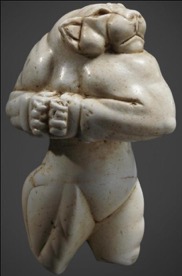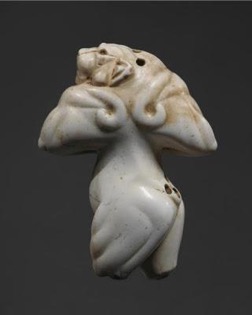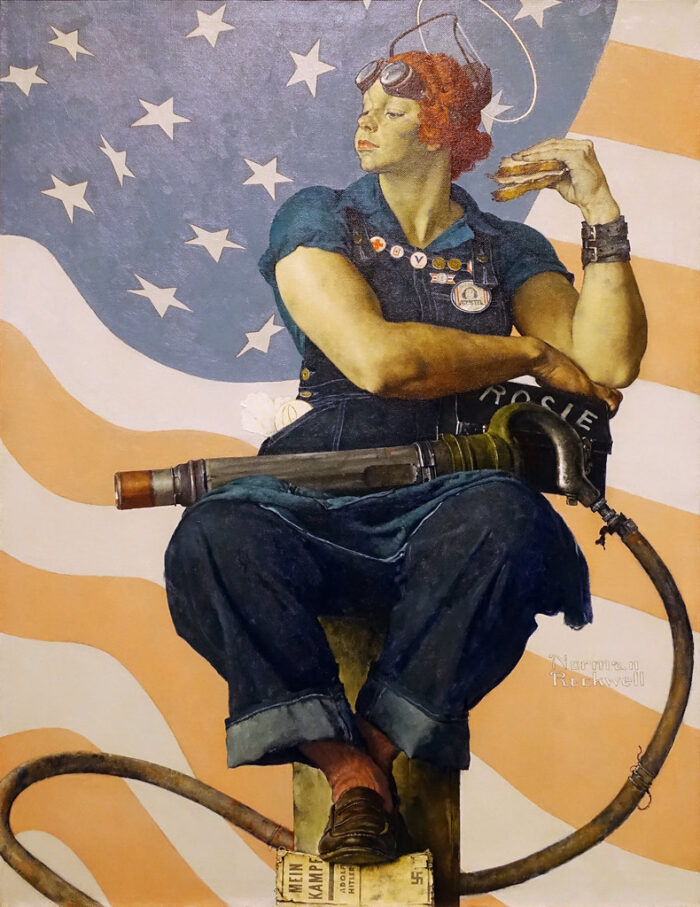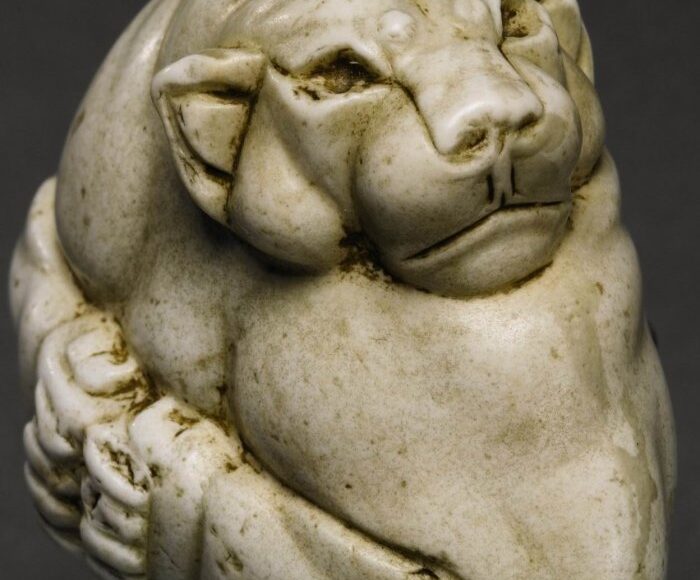Human? Lion? Mythic-woman lioness? How can this tiny 5,000-year-old limestone anthropomorphic sculpture be so powerful yet so modern at the same time? This 3 1/4 inch figurine, found in ancient Mesopotamia, merges human and animal features to create this mythical lioness representation. Despite her small size, this figure conveys an impression of strength, power, and monumentality that reminds us of strong female icons of our time. The magnesite figurine was sold in auction in 2007 for more than 57 million dollars to an anonymous bidder, making it the most expensive sculpture sold at auction at that time. This opens up once again the debate of public versus private collections and who controls our public heritage. We still do not know much about the function and origin of the lioness and it will be difficult to continue evaluating it, since her currents whereabouts are unknown. Does the individual have private researches and conservators? There is no way of knowing. Her mysteries, secrets will be remain unknown and away from the public eye for perhaps a very long time.



The Guennol Lioness was carved approximately 3000–2800 BC; it was found at a site near Baghdad, among a group of other related amulets near the Shara temple at Tell Agrab. This carving has a strong similarity to a series of Proto-Elamite seal impressions, that are currently located in the Louvre, featuring a striding upright leonine beast with paws clutched in front of its torso.

The limestone carving demonstrates an immense amount of skill as the artist merges three twisting human physical poses which add volume and complexity to the figure. To replicate the lionesses’ features, the artist must have been able to observe the animal from a close distance, showing the advancement and strength of the civilization. The artist incorporates the lioness head onto a muscular female body (asides from the lion tail). Other female sculptures such as the Venus of Willendorf or the Babylonian Goddess Ashtart also found in ancient Mesopotamia, may represent maternity and fertility features. However, the Guennol Lioness figurine portrays fierceness and strength.

The lioness stands with her head turned over her left shoulder; her paws are strongly clenched in front of her muscular chest while her upper body turns to the right. The head is carved with finely incised detail, including a wide-set of eyes with circular pupils, that possibly in the past had been filled by gems of some sort. Other sources say it is also possible that the sculpture was painted and decorated with semiprecious stones. As an art history student, I think there is also something very modern in the Lioness. I perceive a connection between the muscular arm and the defiant posture of Rosie the Riveter by J. Howard Miller or by Normal Rockwell and our sculpture goddess.
Despite her relatively small size, the Guennol Lioness conveys an unmistakable impression of strength, power, and monumentality. Scholar Dr. Edith Porada has described the Guennol Lioness as “Perhaps the most striking feature of this sculpture is the impression of monumental power which it conveys. When seen in the original, the figure seems to fill the entire field of mental vision; even in photographs, it gives the illusion of considerable size”(Porada).
Function and Identification
Although scholars have had access to this object for nearly 60 years while it was on display at the Brooklyn Museum, its role within the mythology and the rituals of the Elamite culture remains a matter of speculation. Unfortunately, from now on, its study will depend on the will of its anonymous owner, who since 2007 has decided not to display it for public view. The Guennol Lioness could be a symbol of power, owned by a person of great importance. Other theories state that the fierce aspect of the beast and the power it emanates was meant to repel misfortune and keep malevolent forces at bay. Some art historians, such as Amanda Renshaw refer to the lioness as a demon, yet she states that it could also represent the most important female deity of ancient Mesopotamia: the goddess Inanna, which translated to “The Lady of Heaven”, representing the power of nature. Oftentimes, the Ancient Near Eastern deities were portrayed as figures of both animal and human attributes. The symbol for the goddess Inanna, a ring-post, a reed stalk tied into the loop at the top is carved twice on the Guennol lioness shoulder blades. Due to its pose and the holes drilled into the back of her head, where a chord could be inserted, the lioness could be some sort of amulet possibly worn to demonstrate authority and power or as a charm to ward off evil spirits.
The Auction
The sculpture became part of the Guennol Collection when it was acquired by a private collector, Alastair Bradley Martin in 1948 and it has been on view at the Brooklyn Museum of Art for nearly 60 years. The collection was called “Guennol” after the Welsh name for “Martin” its owner. The Martins love collecting and they were also generous to display it for public view, so the public could all learn and enjoy these treasures of humanity and of the first civilizations. However, in 2007, after the lioness was up for auction at Sotheby’s in New York, it disappeared from public view. Even certain members of the Sotheby’s one of the world biggest art marketplace described the limestone sculpture as “one of the last known masterworks from the dawn of civilization remaining in private hands”. The Guennol lioness was estimated to sell for 14-18$ million yet it tripled its expected price when it was sold for $57.16 million, to an anonymous British bidder making it the most expensive sculpture sold at auction at the time. Interestingly enough there was no public outcry in the press at the moment about the disappearance of our Goddess from public view.
The wonder, power, and mystery surrounding the Lioness of Guennol remind us of monumental and urgent debate: Who controls our cultural heritage? Pieces like this are part of our collective memory and should be accessible for public enjoyment and study. This artifact might hold precious information about the cradle of human civilization where it was found. As stated in a Conversation Magazine article by Kathryn Brown; “Museum culture’s “drift” into private ownership seems part of a familiar pattern.” Such a relevant treasure should not be up for sale to the highest bidder, and private collections should be regulated with periods of the mandatory display so that everyone can appreciate our history. Treasures like this should not be considered as a possession but a repository of human knowledge. I really wish I could see this sculpture today in person, feel her magnetism which is still strong and present, even in photographs. Yet its whereabouts are unknown, and it may never return to the public eye. In the 21st century, art privatization has become more popular, audiences need to be aware of these issues of collective heritage and acknowledge the economic stance some institutions are supporting.
Byline/quick note from author:
Hello! My name is Lucia; thank you for taking the time to read my post. I have always had a fascination with Art History, in fact I am considering in being an Art History or a Museum Studies minor. When I came upon this beautiful, mysterious lioness I was so fascinated by it! It is such a delicate yet powerful and monumental artifact, that almost looks modern to me. Blending a lion with a female body, its angles somewhat reminding me of a cubist abstract animal of Picasso. I have so many questions about it, and I was shocked when I found out that this little figure was sold for millions, yet its location is currently unkown. I also have a particular interest in exploring auctioneering and the art market world; I applying to intern at Sotheby’s or Christies this summer, and the debate of private collection is thrilling to me as well.
